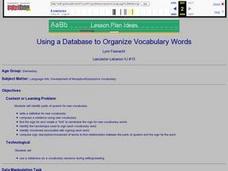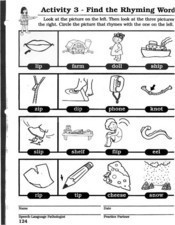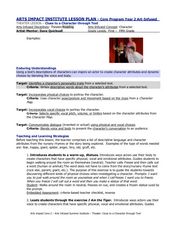Curated OER
Using a Database to Organize Vocabulary Words
Students use a database as a vocabulary resource during writing/reading. They preview stories and list unknown works into their reading notebooks. Students find the definitions, and enter their words into a database using a teacher...
Learning Links
The Josefina Story Quilt Study Guide
Considering using The Josefina Story Quilt in your classroom? Check out this sample teaching guide for a list of pre-reading activities.
Curated OER
Basic Writing Skills
Learners listen to story A Mason-Dixon Memory, by Clifton Davis, and complete worksheets about the story. The worksheets are embedded in the plan. This activity provides good reading comprehension practice for young readers.
State of South Dakota K-12 Data Center
Find the Rhyming Word
When two words have the same rime, it means they both end with the same phonemic blend. Little ones hone their phonics skills as they say and then choose the image/word that rhymes with the one in the first column. They'll match words...
K5 Learning
Snowman
Young scholars read a brief text detailing a conversation between two children about building a snowman, then show what they know by way of four reading comprehension questions.
Curated OER
Why Koala Has A Stumpy Tail
First graders read the story Why Koala Has A Stumpy Tail and complete language arts activities with it. Students have discussions, read, write, spell, and act out the story.
Curated OER
Can We Switch Genders of Story Characters?
Students read and review the main elements of a story. In this language arts lesson, students predict what the story read to them would have been like if the genders of the characters had been different. Students write a new story in...
Curated OER
Getting Adults and Children to Talk
Students engage in activities to practice their speaking skills. They role play, tell stories, use puppets and props, play games and solve puzzles. They sing songs and use rhymes to practice repetition. They read and respond to articles...
Curated OER
Reading English School-Home Links
For this literacy worksheet, 1st graders practice reading a story as their home learning partner points to the words. They examine the directionality of reading the English language.
Curated OER
The Magic Apple
A fun and delicious lesson can help your kids learn about plural nouns and story sequencing. After reading The Magic Apple by Rob Cleveland, kids match pictures to story segments and add s to nouns to make them plural. They then cook...
Curated OER
Chicken Soup With Rice
Complete a variety of activities related to the Maurice Sendak's book Chicken Soup With Rice. Readers identify the months of the year, identify words starting with the letter J, explore online illustrations created by Maurice Sendak, and...
American Institute of Architects
Architecture: It's Elementary!—First Grade
Build an interest and appreciation for architecture in your young learners with this fun 10-lesson art unit. Engaging children in using their five senses, the class first observes the environment around them, paying special attention to...
Super Duper Publications
Deletion of Syllables
A great addition to a speech pathologist's toolbox, this worksheet focuses on deletion of syllables without using compound words. Children listen to the complete two-syllable word before reciting one syllable of each, based on the...
Curated OER
Editing Marks, Part 1
Dander from the show Twisted Whiskers and characters from My Little Pony are featured in this three part lesson plan that explores using story pyramids to scaffold ideas, adding sensory details to enrich writing, and editing using common...
Scholastic
Fly Guy Maze
Invite your kids to fly from the start to the end of this maze. Based around Hi! Fly Guy by Tedd Arnold, the goal of the maze is to help Fly Guy and Buzz Boy escape a pirate ship.
Education City
Reading Comprehension
Celebrate National Reading Month in March—or any month of the year—with a selection of versatile graphic organizers. The worksheets prompt readers to compare characters easily, predict what will happen next in a story, track their...
We are Teachers
Read Like a Detective
Encourage your young readers to become true detectives in their next literary adventure! Here you'll find an attractive display that will prompt your learners to constantly be looking for clues, asking questions, making cases about the...
Scholastic
Make Your Own Fly Guy Comic
Is your class reading Hi! Fly Guy by Tedd Arnold? Get them involved in the story-creation process with this partially blank comic strip template. Learners take a look at the first and last panels and then fill in the remaining four with...
Curated OER
Penguin Writing
After discussing the main events in Mr. Popper’s Penguins, young writers describe in sequence what they would do if they had 12 penguins living in their house. The narratives are then glued onto a penguin cut-out, mounted on construction...
Curated OER
Women
A close study of two works of art provides the introduction to this cross-curricular writing assignment. After comparing the clothing, facial expressions, body language, setting, and color in the two 19th century paintings Tissout’s...
Curated OER
Conversation Heart Bingo
Primary learners play conversation heart bingo in order to write common phrases. They will create a bingo card with common phrases from conversation heart candy. The teacher calls out phrases and the learners cover them with conversation...
Curated OER
Clues to a Character through Text
Readers will read a text and fill out a character map based on the characters in that text. They will explore different qualities of each character for their map. this can be modified to support younger learners. They will learn about...
Curated OER
Applying Phonetic Principles
Young readers develop their phonetic skills by using a nifty tool called a word pocket. They use the tool to help them organize individual letters that they have at their desks to spell entire words and to construct beginning and ending...
Curated OER
Writing to a Specific Topic
After a class discussion where learners make predictions about what will happen in a book based on its cover illustration, pupils are asked to compose a written response about an aspect of the story and include some of their own...

























